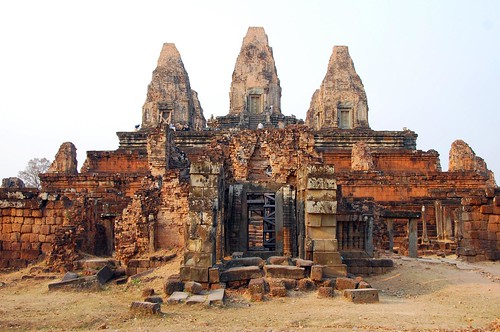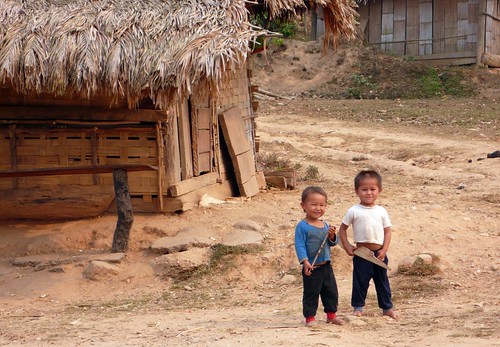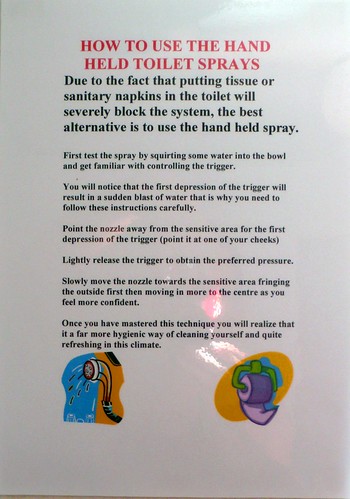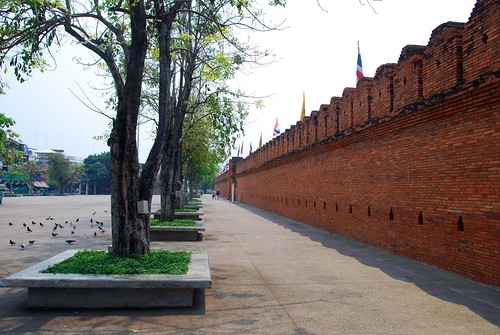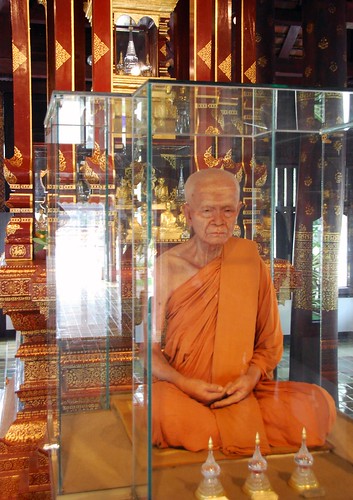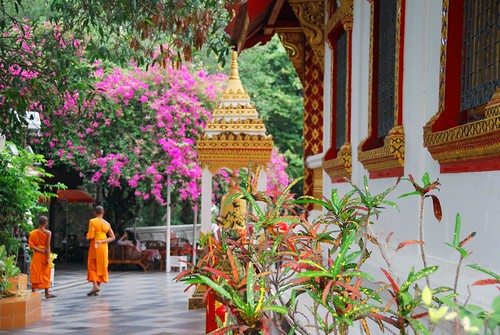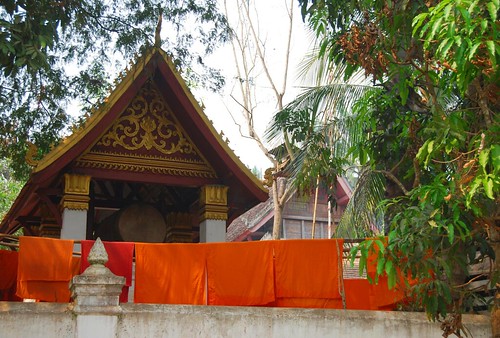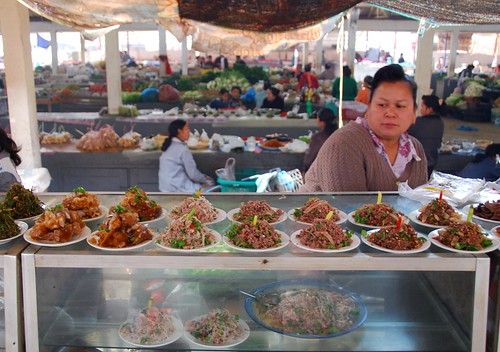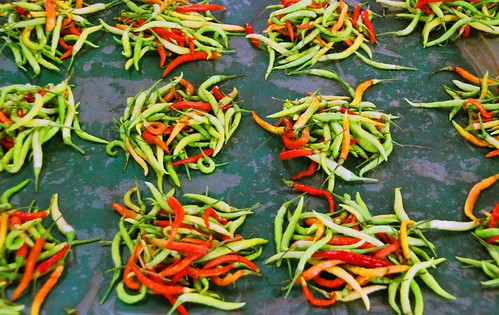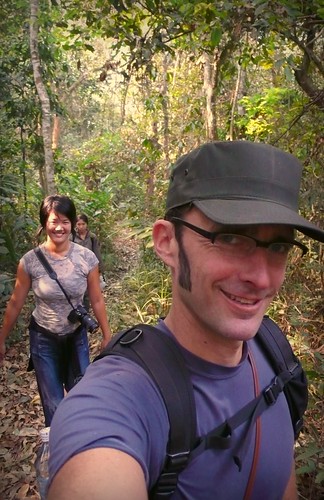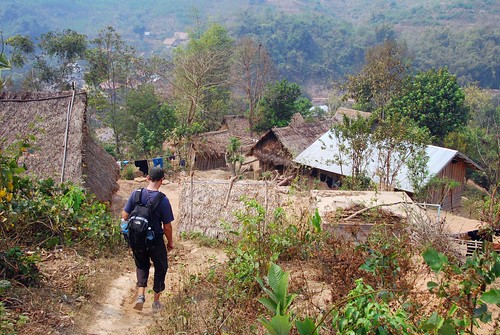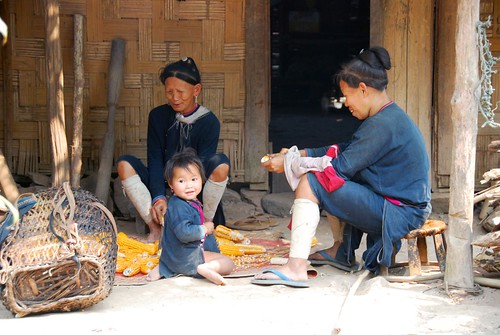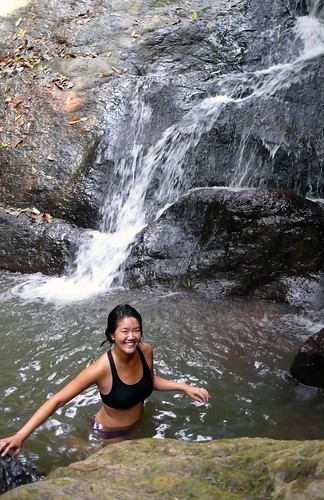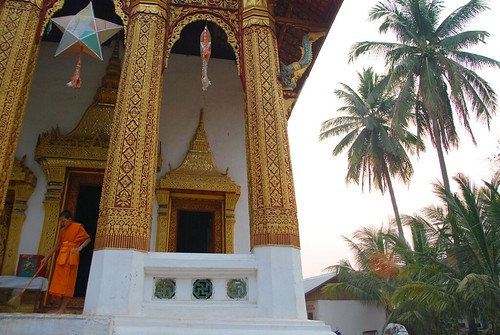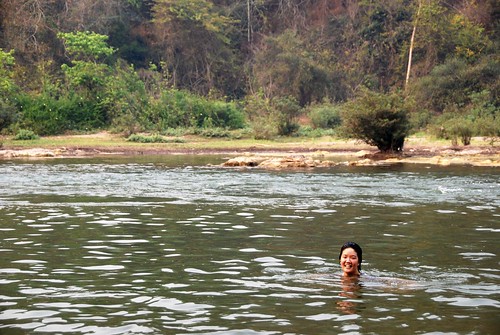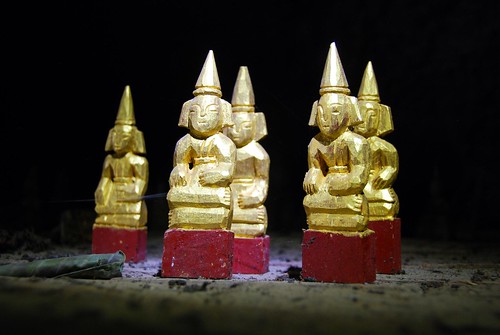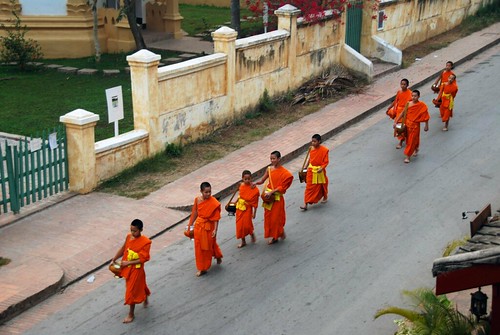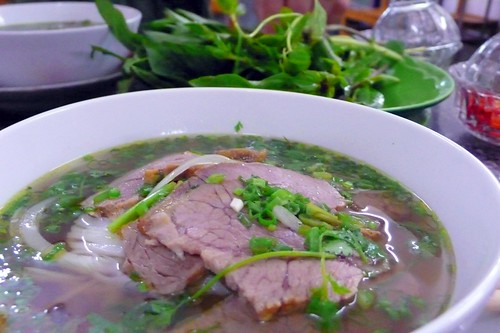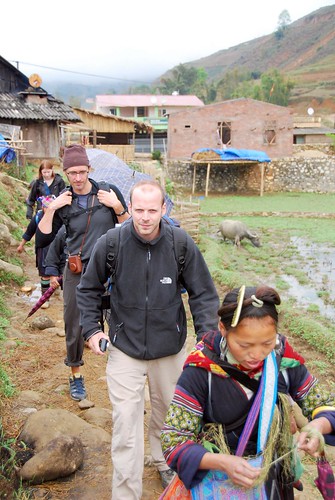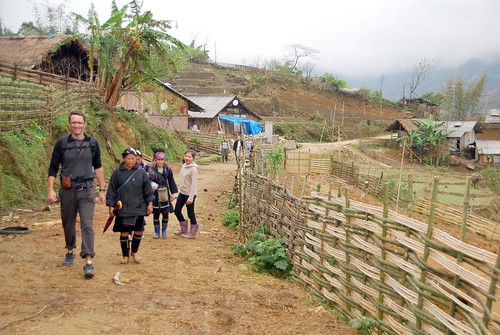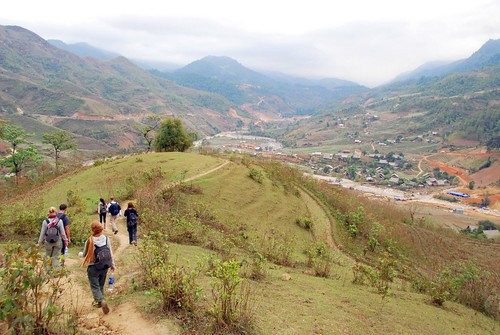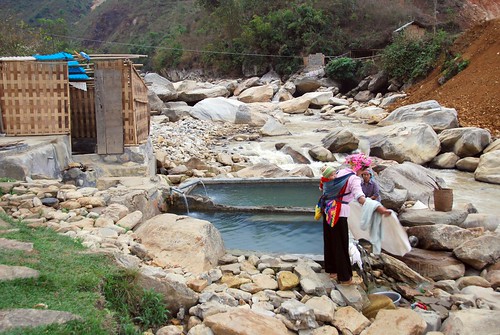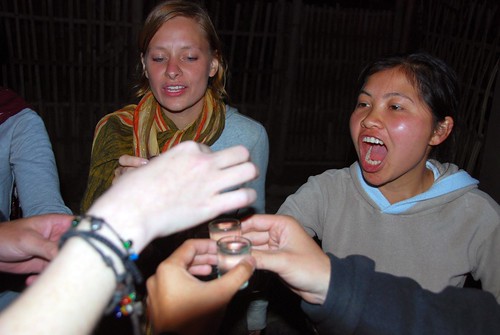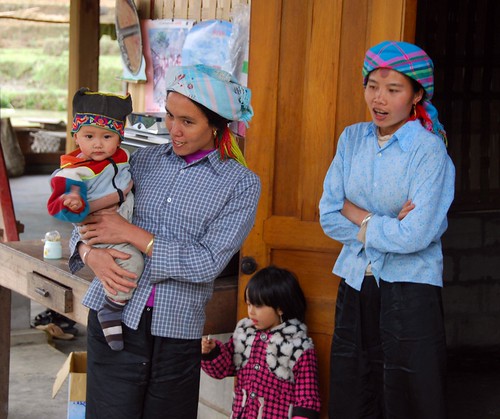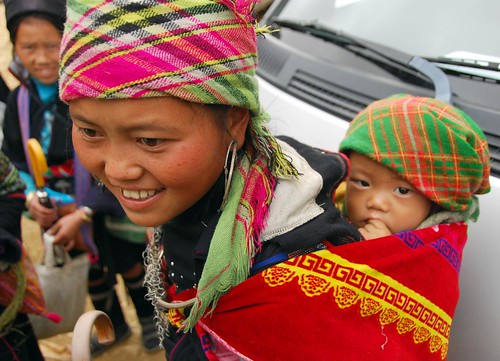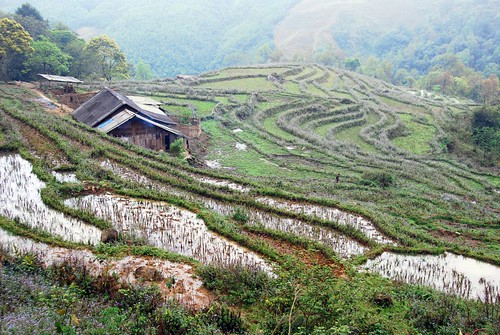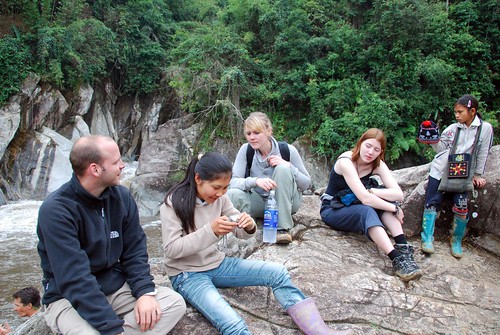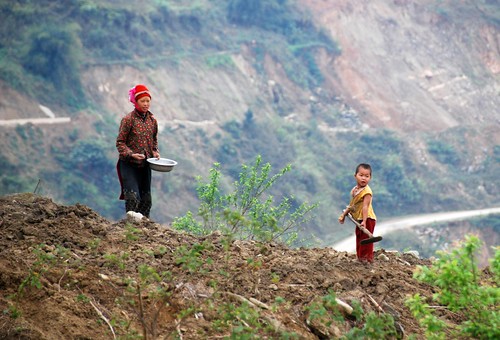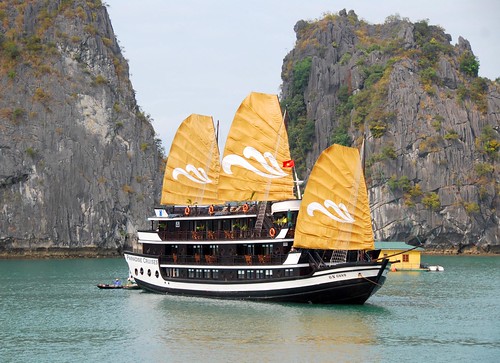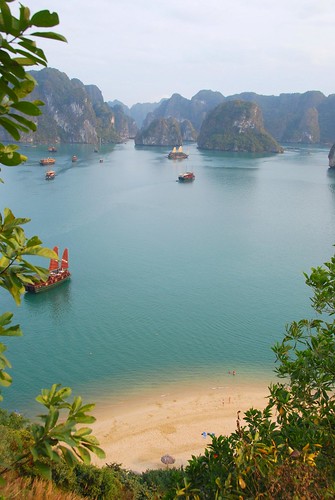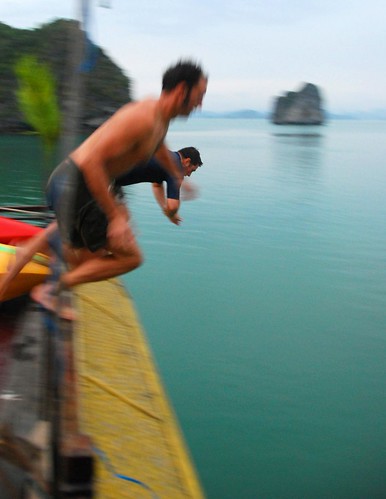Southeast Asia
Note: I had intended to do mini-recaps for each country we visited in SE Asia, and then tie it all up with one big, pretty SE Asia recap bow, but the country-specific recaps turned out to be quite in-depth, so I’ll keep this one short too.
Wow, where to even begin? Well, if the measure of an experience is what you are left with after it is over, let’s examine what gifts traveling in SE Asia bestowed upon us, shall we? An intense love for swimming in the ocean. Consciousness, complexity, and compassion. A new pair of flip-flops. The most amazing thing I have ever seen. An unforgettable birthday experience. The ability to peel and eat a bamboo shoot. New friends. And perhaps most telling: the desire to travel to more undeveloped countries (seriously, there are changes a’coming to our travel itinerary…stay tuned). New Zealand and Australia were amazing experiences in their own right, but it was only through our travels in SE Asia that our Internal Normality Indicators (INI) were recalibrated: a family of 5 on a single motorbike? No problem. People walking their pet elephants on the street? OK. Children who just barely learned to walk trying to sell you tourist trinkets? I don’t like it but I understand it. Congealed pig’s blood cakes? Yes. These are things that you just won’t encounter in the Western world, either because they aren’t necessary or because we have other options. And that’s why we travel, right? To challenge our familiar; to make sure our understanding is always growing wider and not narrower; to hit that INI reset button.
Days spent here: 59
Countries visited: Thailand (recap), Malaysia, Cambodia (recap), Vietnam (recap), Laos (recap)
Highlights: Ko Lipe, Penang, Siem Reap, Dalat, Sapa
Pre Rup at sunset. The Temples of Angkor, Siem Reap.
Places we would like to visit next time: Southern Laos, Myanmar/Burma, Indonesia
Average daily expenditures: US$80
Prices: The word is out…SE Asia is no longer the super-cheap destination it once was. Don’t get us wrong—it’s still very affordable, but we were expecting to spend about US$50 per day (between the two of us) and we ended up at US$80 per day. We still don’t understand how we managed to do this…our typical accommodation cost about US$15 per night and our meals averaged between US$2-10 (for the two of us). We moved around quite a bit so perhaps all the transportation costs hurt our bottom line more than we expected.
Guide books: We’ve already mentioned how indispensable Lonely Planet’s Southeast Asia on a Shoestring is to traveling in SE Asia…but it can be quite thin if you want to get off the beaten path. Here’s one way to remedy the situation: there are lots of copy books for sale in SE Asia (basically, a printer just Xeroxes a book and binds it). The copies are typically of very poor quality (it will be difficult to read the maps), but they are cheap (between US$2-5). You can buy these copy books to supplement the info in your original copy of Southeast Asia on a Shoestring. Not that we would ever buy pirated books. No sir.
Internet: Coming from Australia, where we had to spend the better part of the afternoon at the public library if we wanted a wireless connection, we were shocked by how widely available wireless access was in SE Asia. In many countries, guest houses and restaurants have wireless, but access is password locked. Here’s a hint: try “123456790.” Seriously, we were able to access at least 10 wireless connections using this password. Let us know if you want to hire us as hackers when we get back to the States, we obviously have very advanced technological skills that cannot be replicated by mere mortals.
Children: It’s not just us, because we heard it from many other travelers: the kids in SE Asia with break your heart. Even if you are a card-carrying member of the Anti-Breeder Association of Steel-Hearted Non-Procreators, these kids will get to you. And there are a lot of them! In Vietnam, something like 75% of its population is under the age of 30 (that may not be the exact figure, but it’s ridiculously high like that).
Little Laotian troublemakers.
The deal with TP: Remember how I complained that Khao San guesthouses did not provide TP in their rooms? Well, we figured out why: most people in SE Asia don’t use it. Now before you get all grossed out, here’s the deal: next to every toilet, there is a hand-held spray nozzle. SE Asians use this to clean themselves instead of toilet paper. Not to get into too many details, but we learned to really prefer this method too (though we didn’t eschew TP altogether). It is much more hygienic than just using TP. Jeremy swears that he is building a bidet into the next house we live in.
In case you’re confused as to the specifics of using one of these hoses, our guest house in Chiang Mai posted a rather humorous but helpful sign on the bathroom wall:
Also, note that you should carry toilet tissue with you at all times since most public restrooms do not provide it.
In short: Just go.
Ever since I caught the travel bug on my first trip to Central America, I have wanted to visit Thailand. Something about the place held my fascination, though I had but a few expectations before we arrived: that the land would be beautiful (it is), that the people would be peaceful (they are, though the protests right now may suggest otherwise), and that the food would be good (well, you know where we stand on that issue). It’s funny, though…traveling to a new country can be just like shopping from a catalog, you never know if something is going to fit unless you try it on. Despite the beautiful landscape and the gracious people, I have to admit that we left a bit disheartened by some (definitely not all) of our experiences in Thailand. I think it has to do with the fact that there are so many Western tourists in the country…but before you throw up your hands and say, “Oh, Hope and Jeremy didn’t like Thailand because it’s too touristy,” let me explain. It’s not the fact that there are so many Westerners here, I mean, if that’s the case, then shame on us for only adding to the problem, right? Rather, it is tourism’s effect upon the local people that didn’t sit right with us. Perhaps it’s because so many party people and sex tourists come to Thailand, or maybe Thais are just tired of working so hard to embrace the hordes of travelers coming to their country and not getting anything out of it. We found it difficult (in some places) to connect with locals beyond the standard service-industry interactions, leaving us discouraged and a little depressed. To be clear, I don’t blame Thai people at all…they are more than polite and accommodating towards travelers in their country. Rather, I think it is just a social condition that has manifested itself as a result of a few wayward Westerners treating parts of Thailand like their own personal playground.
That being said, I do want to point out that we had a wonderful time with Oak and his wife in Bangkok. I mean, this is a guy who told us (as we were leaving his house for the airport), “You know where your home in Bangkok is.” We know that it’s not every day you encounter that kind of open-heartedness and generosity. So even if Thailand could taste a bit sour at times, we were also left with a sweet taste in our mouths from the experience.
Days spent here: 19
Places we visited: Bangkok, Krabi, Ko Lipe, Chiang Mai
Places we would like to go next time: Similan Islands
Prices: With the exception of Chiang Mai (which is super cheap), we found Thailand to be quite expensive, especially in terms of accommodation. One of the worst rooms we stayed in in SE Asia (in Krabi) was also one of the spendier ones (at US$18.50 per night), and the most expensive room we stayed in all of SE Asia was in Ko Lipe (at US$26 per night). Food in Thailand can be quite cheap, however, as long as you like pad thai and fruit shakes. ![]()
Weather: The weather was beautiful while we were in Thailand. It was hot and dry in the south (at the end of January), and hot and humid in the north (mid-March).

Sunrise over Ton Sai beach in Krabi.
In order to deal with the heat, Thais (apparently) bathe several times a day. They also use baby powder to keep themselves dry, and the options are amazingly broad. There are baby powders with cooling agents, baby powders that help control acne, baby powders that shimmer, baby powders with deodorant…the list goes on. We tried the baby powder thing and we have to say, it is quite refreshing!
Transit: We traveled in Thailand on plane, mini-bus, boat, and train. Mini-buses in Thailand are not the holy terrors that they are in Vietnam…we enjoyed a very comfortable 5-hour ride from Chiang Khong to Chiang Mai via mini-bus transport. Similarly, the train from Chiang Mai to Bangkok was very comfortable, but try to get a bottom bed, as they are much wider than the top berths.
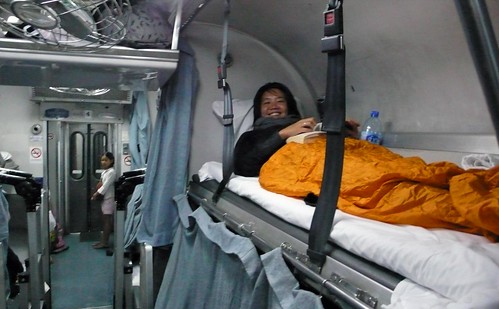
Settling in for the night. On the overnight train from Chiang Mai to Bangkok.
Internet: Wi-fi connections in Thailand are plentiful, though we always had to pay for access (usually between 30 and 50 baht per hour: approx. US$0.85 to US$1.50).
Culture: Thailand is a very Buddhist country, which accounts for the peaceful nature of its people. There are many opportunities to do 10-day introductory meditation retreats at Buddhist monasteries here (which we really wanted to do but alas did not have time for). If you do decide to take part in one of these courses, be prepared to sleep on a concrete bed with a wooden pillow, wake up at 4AM, and deal with rats, snakes, and mosquitos (Buddhist monks do not believe in killing any living creatures, so rodents of all sizes can take safe shelter at their local monastery). Also, you are not allowed to eat after noon (this tenet in particular scared Jeremy).
The other person (besides the Buddha) that Thais worship is their King. Oh my god, do they love their King. You cannot walk a block without seeing his face. Every little hole-in-the-wall restaurant has a small shrine devoted to him with shells and flowers and stickers decoupaged around his portrait. His face is all over their coins and bills, and it Thailand it is against the law to step on money, since to do so is to disrespect the King. By the way, as far as we could gather, the King’s role is sort of like the Queen of England—purely ceremonial.
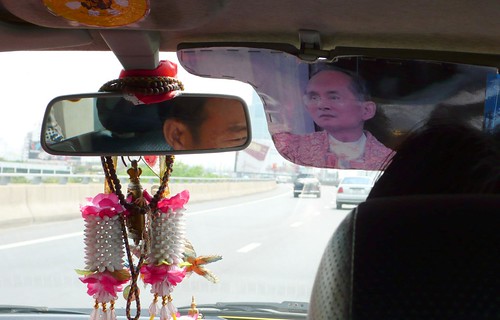
One of our taxi drivers stapled a portrait of the king to his car’s visor. So cute!
The final bit of Thai culture that I wanted to mention is the wai, the standard way of greeting people in Thailand. Basically, you hold your hands together in front of your face and say, “sawatdee” (”hello” in Thai). If someone wai’s you, it is polite to wai back, though the position of your hands does matter. It seems that wai’ing so that your fingertips are touching your forehead is a sign of utmost respect, but when in doubt, just make sure your fingertips are right underneath your nose. Hold your hands too low in relation to your face, and you risk offending someone.
In short: I don’t mean to be too negative about Thailand…in fact, if I think back to the places we visited, we liked all of them and had a really nice time in each location (especially Ko Lipe). It’s just that you can feel the effect of tourism in Thailand more than in other SE Asian countries. I guess it was the surprise of encountering this reality that threw us a bit off balance.
Check out our photos from Thailand:
We’ve come full circle…our final stop in SE Asia was the same place we started: Bangkok. As many backpackers will tell you, you really don’t want to hang out in Bangkok for too long. We did our best to avoid the place but we had some visa issues that needed some attention, so back to Khao San Road we went. It’s funny how much your view of a place changes after you have something to compare it to…when we first flew into Bangkok, Khao San Road seemed fine; nothing to write home about, but we weren’t repulsed by it either. I guess it’s because we had no point of reference. After seeing what the rest of SE Asia has to offer, Khao San seemed like an absolute pit and we couldn’t wait to move on (next time, we think we will stay in the Siam Square area instead).
We didn’t do much else in Bangkok except take care of our visas, but we did manage to see Oak one more time. Oak invited us to stay with him and his wife in their newly-built house as their first overnight guests. It was quite a shock to go from Khao San to their gorgeous, multi-level house. Since the house is so new, it is very sparsely furnished, but you can already see that Oak and his wife Auey’s tastes veer towards the modern: everything is black or sparkling white.
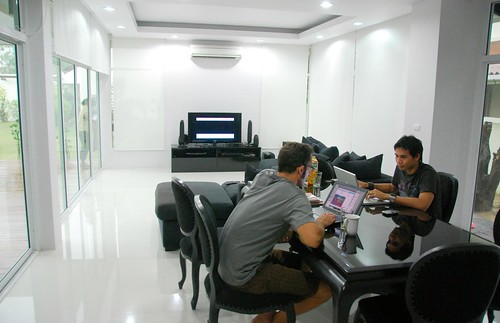
Jeremy and Oak computing at Oak’s dining room table.
It was against this stark white background that we realized: we were dirty. Seriously, we never felt so dirty in our lives…and we fancy ourselves much cleaner than other backpackers! It was embarrassing. We quickly took showers and changed into our nicest (cleanest) clothes. I even put on a pair of earrings, hoping that might distract from our disheveled bodies. I guess we had been amongst dirty backpackers for too long…our hygiene scale got a little skewed. ![]()
We also got to see Oak’s Muay Thai (Thai Kickboxing) manufacturing plant, and he gave us free t-shirts from his line…so nice!

Thai kickboxing gloves at Oak’s warehouse. Buy them here: muaythaistuff.com!
Oak also took us out to a steakhouse…which was amazing! Even better, the restaurant had a Western theme, complete with wagon wheel chandeliers and Thai waiters dressed in Western gear. Thais have this strange fascination with the wild west…we saw many an “Ol’ Saloon” and “Wild West Steakhouse” in Bangkok and Chiang Mai.
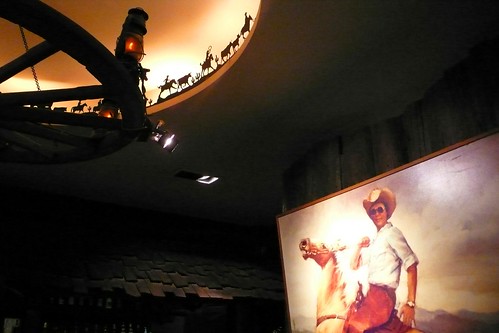
Is it just me or does the Thai cowboy in the portrait look like my dad?
It was a great way to close out our trip: great food (notice that we did not want Thai food for our last meal in SE Asia) ;), followed by a night out with new friends, ending in the comfort and luxury of sleeping in Oak & Auey’s (gorgeous) house. We had a great time in SE Asia, but we’re looking forward to the next chapter in our trip: Taiwan!
Chiang Mai is the only major stop on the backpacker circuit in northern Thailand, and it seems to have a little something for everyone. For the spiritually-minded, Chiang Mai has a plenitude of wats, some offering 3-10 day meditation retreats (which we seriously considered but didn’t have time for) or afternoon “monk chats.” For the active traveler, Chiang Mai is a very popular place to book a multi-day trek to visit hill-tribe villages, including the famous “long necks” (i.e., women from the Kayan-Padaung tribe who wear brass rings around their throats, giving their necks an elongated look). And for the shopper, Chiang Mai is famous for it’s handicrafts and night markets, selling everything from embroidered textiles to paper umbrellas. With so much to see and do, you can’t go wrong, right? Well, read on, my friends…Chiang Mai was really lovely but one thing in particular really ended up being the thorn on our rose.
As a city, Chiang Mai is pretty cool. The city center used to be walled in and protected by a moat, though little of the wall remains except for the corners and the city gates. Still, it’s pretty neat! I mean, how excited would you be to live in a town with a freakin’ moat?!?
Within the walls sits a plethora of wats…you can’t walk a block without running into one, they are like Starbucks here. We spent many a day wandering around wats. The “Big Three” within the walled city are Wat Prasingh, Wat Chiang Mun (the oldest wat in Chiang Mai) and Wat Jedi Luang.
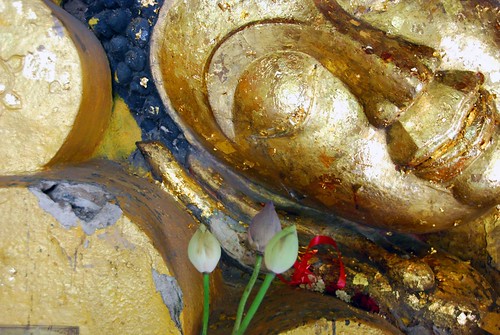
Big sleeping Buddha at Wat Jedi Luang.
In the back of Wat Jedi Luang, there are some beautiful old teakwood buildings that contain life-size wax replicas of monks within plexiglass display cases. Needless to say, we were surprised, fascinated, and a bit creeped out by these.
One day, we rented bikes and rode out to Wat Umong, a forest wat outside of the city center, in order to attend a talk by a western monk entitled “What Buddha Taught.” It was really informal…there were only about 6 of us sitting around an outdoor gazebo listening to a monk talk about the Buddha’s teachings. Jeremy and I have been practicing meditation lately and we’ve become really interested in learning more about Buddhism. The talk was super interesting and the monk (we think he was English) was surprisingly well-versed on current events; during his talk, he mentioned the credit crisis, iPod touches, and the contemporary Australian philosopher Peter Singer. I didn’t take any photos at the talk, but Wat Umong itself was really lovely. It is not ornate and gilded like the wats in the city center, and the rustic nature of the grounds is thoroughly charming.
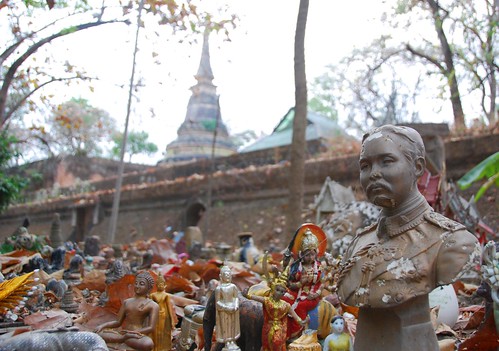
Random assortment of icon relics at Wat Umong.
Also, this wat is unusual in that it has an assortment of tunnels that lead to little altars and shrines to the Buddha.
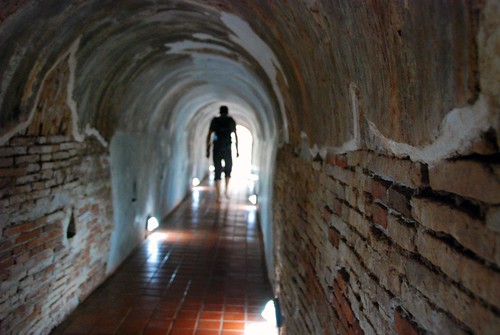
The underground tunnels at Wat Umong.
There are a few sights right outside of Chiang Mai that are really popular, too. You’ll have to rent a scooter (as we did) or take a tuk-tuk to get to Bo Sang, a “handicraft village” (if by “village” you mean, “street with shops”). It was kind of lame, but we did wander around some of the alleys off the main drag and there are families actually producing things like handmade paper and painted umbrellas (apparently Chiang Mai is really well known for these).

Handmade paper drying in the sun.
We also scooted out to Mount Suthep, where Wat Phrathat Doi Suthep (a.k.a. “The Wat on the Mountain”) is located. It was a really lovely place, but incredibly crowded, too.
There weren’t any wax-figure monks in plexiglass cases at this wat, but they did have this weird thing:
Apparently whoever made this statue did not think too highly of their mother. Or there is a cultural “lost-in-translation” moment here that we are not understanding.
So enough about wats…what about the other activities that Chiang Mai has to offer? Well, we didn’t end up going on a trek because, like northern Laos, it is burning season in Chiang Mai too, and after our Luang Nam Tha experience, we decided to skip it. I think this was a good decision, because the day we rented the scooter, both Jeremy and I had problems with the smoke…I ended up with a sore throat and cough for days, and the white spots on my purse had turned completely grey. Gross!
We did, however check out Chiang Mai’s biggest tourist attraction: the markets. We were lucky enough to be in Chiang Mai on a Saturday and Sunday, so we got a taste of the weekend mayhem. Saturday night’s market is much smaller and more relaxed…Sunday’s market is absolutely nuts! The entire length of the main street in Chiang Mai’s city center is blocked off and the road is filled with handicraft stalls, people offering cheap massages, and snack treats. Even if you had the energy to walk from one end to the other, it would take you hours, since the wall of people is so thick. It was so crowded, Jeremy couldn’t deal with it and went home early. ![]()
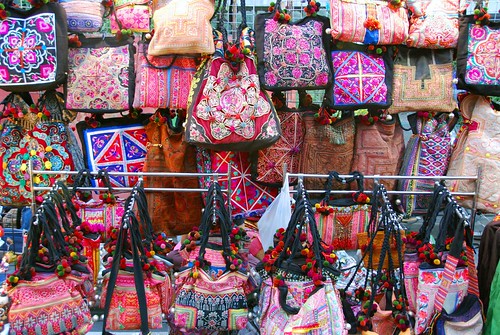
Amazing embroidered purses at the Sunday market.
So…wats, treks, and markets, what more could you ask for, right? Well, the thing is…are you ready? You might want to sit down.
Jeremy and I don’t like Thai food.
I know! Can you believe it? Us! Lovers of all cuisine! Equal opportunity eaters! We just don’t care for one of the world’s favorite ethnic foods! I was shocked to find out too! But guess what? It was a two-way street: Thai food doesn’t like us either. We had (ahem) issues in Chiang Mai…to the point where we were afraid to even eat Thai cuisine. We actually sought out Western food like spaghetti and hamburgers in Chiang Mai. I know! Us! Can you believe it? I mean, we ate congealed pig’s blood cakes (unknowingly, but still) in Penang, and something called “cockles.” And it was northern Thai food that took us down.
It was depressing. When you love food as much as we do, you can have the most amazing time in a place, but if the food’s not good (much less, making you sick), then it’s hard to really enjoy yourself. And the weird thing is, we like Thai food in the States. We just didn’t like it in Thailand.
So, there you go…that was our Chiang Mai experience: days spent lazily wandering in and out of beautiful wats, an incredibly interesting talk by a local monk, riding around the walled city on our rented bicycles…but the pea under the princess’ mattress was the food.
Sorry, Chiang Mai. Let’s just agree to disagree, shall we?
If there is one thing you won’t want to do in Laos, it’s rush. We really didn’t get to spend enough time here or see that much of the country, but we were in Laos long enough to get the flavor of the place. And what exactly does Laos taste like? Dust. Sticky rice. Tranquility. Shyness. Noodle soup. Divinity. Poverty. Beerlao. Golden sunsets. And, if it is possible to taste such a thing, the flavor of time standing still.
Day spent here: 7
Places we visited: Luang Prabang, Luang Nam Tha
Places we would like to visit next time: Southern Laos, especially Champasak and Si Phan Don
Prices: We found the prices in Luang Prabang to be quite high. It is possible to find cheap accommodation and food, but it’s no fun eating at the market every night. Every so often, you want to eat in a restaurant, and in LP, that can set you back about US$5-10 per person. On the other hand, Luang Nam Tha was quite cheap…we paid 60,000 kip (approx. US$7) for our room, and dinners at the local restaurant were only about US$3-5 each (even cheaper for a bowl of noodles at the LNT night market).
Similar to Vietnam, prices in Laos are often quoted in US dollars, though you can pay with dollars, kip, or even Thai baht. The exchange rate was US$1 = 8,500 kip.
Weather: While we were in Laos (early March), it was nothing but HOT. There was not a whisper of wind to speak of, and combined with the smoke in the air, it made the heat very oppressive.
Transit: We traveled only by public bus in Laos…there were no other options to the areas we were headed (Luang Prabang to Luang Nam Tha, and Luang Nam Tha to the border town of Huay Xai).
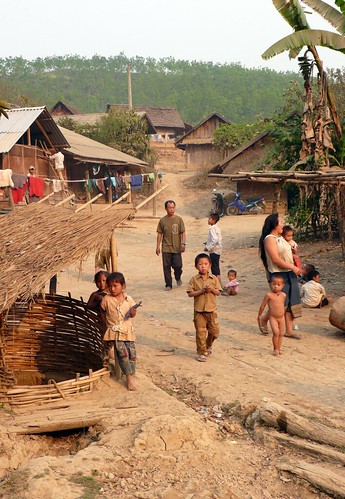
Village kids running to gawk at us on the public bus. Somwhere between Luang Nam Tha and Huay Xai.
Laotian public buses are old are they are notorious for breaking down, though luckily, this never happened to us. The roads are not exactly in the best condition, so bus rides are typically very long and bumpy. Also, Laotian public buses do not have air conditioning, so the windows are left open, leaving you and your lungs covered in layers of Laotian dust.
Internet: Our free Internet spree ended once we boarded the plane in Hanoi. Wireless internet was available in Luang Prabang, usually for about 10,000 kip per hour. Connection speeds were quite slow, however. There was no wireless in Luang Nam Tha.
Food and drink: You have not had Laotian food until you have had sticky rice. It is served in a woven bamboo basket and eaten with the hands (you pull out a chunk, and pinch your meat/vegetables between the sticky rice).
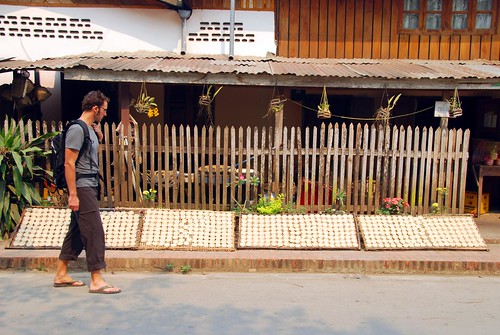
Jeremy walking by some sticky rice cakes drying in the sun, Luang Prabang.
Otherwise, Laotian food is very similar to Thai food. Their rice noodle soups are tasty! Also, the bread in Laos is incredible. Vietnamese French bread is very airy, but Laotian bread is dense, more similar to the bread in France. For lack of a better way of describing it, the bread in Laos seemed more “gourmet.” In Luang Prabang, we found these Laotian sandwiches at the market that were stuffed with grilled chicken, tofu, lettuce, cucumber, and then drizzled with sweet chili sauce. At 10,000 kip (approx. US$1.20) per sandwich, these sandwiches were our tasty, cheap, and filling lunch treats on many LP days.
Similarly, you cannot leave Laos without drinking Beerlao. That’s not a command, it’s an actuality…I am not sure if you an even get any other beers in small Laotian towns! It’s cheap, too…about 12,000 kip for a big bottle which you can split amongst two (or not, depending on how much you drink). ![]()
Culture: Laotians are a very shy and reserved (but sweet) people. Coming from Vietnam, it can be both a positive and negative culture shock; positive because everyone pretty much leaves you alone (which is nice after being constantly harassed to spend your money on this or that in Vietnam), but negative because it is harder to get to know the people here. I think that’s why it’s a good idea to linger a while in Laos, it seems like the kind of place that grows on you (and vice versa). Unfortunately, we just didn’t have enough time to spend here.
That reserved nature carries itself into the culture in other interesting ways…for instance, all around town (in both LP and LNT), there are signs posted in English explaining how Westerners should behave in Laos (i.e., don’t point the bottom of your feet at Buddhas, public displays of affection are frowned upon, women should not touch monks, etc.). Laotians (or at least the government) seem very interested in preserving Laotian culture (though we’ve heard rumblings that this could be due to paranoia rather than any lofty cultural goals—apparently the government is ever-wary of the US invading its social, cultural, and governmental structures, even though most Americans would most likely not be able to point Laos out on a map).
In other ways, though, we found Laos to be quite progressive. Certainly the artisan culture is very alive here and we were pleasantly surprised by the quality and variety of souvenirs and trinkets aimed at the tourist market. Whereas in other SE Asian countries the offerings were limited to cheap plastic sunglasses and logo t-shirts, in Luang Prabang, we saw beautiful embroidered quilts, woven tapestries, and handmade books.

Textile weaver in Ban Phanom village outside of Luang Prabang.
In short: Most travelers probably love Laos because, unlike other SE Asian countries, the people will just leave you be and let you enjoy the country without their intervention. I will admit that Laos’ peaceful nature is really seductive, but on the other hand, chance encounters with locals is what makes a place really special (for me anyway)—I treasure the opportunity to learn about their world through their eyes. Since Laotians are naturally more reserved, it can take a while to figure out how to get them to open up to you. I wish we had more time to spend in this lovely country, a week was not enough time to lure Laos out of its shell.
While most people spend their days in southern SE Asia lying around on pristine beaches, drinking fresh fruit shakes, and snorkeling in warm ocean water, the north’s main activity is trekking, usually to hill-tribe minority villages. Multi-day treks are very popular in northern Vietnam, Laos, and Thailand. We had such an amazing time on our Sapa trek, we decided to head north from Luang Prabang towards Luang Nam Tha, a small town that doesn’t seem to have much going on for it except that it makes a convenient base for exploring the nearby Nam Ha National Protected Area (NPA). LNT has been celebrated for its commitment to ecotourism principles…local tour agencies not only limit the number of trekkers in a group in order to diminish the impact on the environment, but they ensure that a large percentage of the trek fee (usually about 30%) goes towards the village, and each agency offers completely different trek routes so that money coming into the area is distributed fairly amongst the minority tribes. Sounds awesome, huh?
Well, it was and it wasn’t. From what we understand, the LNT tourism industry is still in its infancy, and there were some odd practices in place that didn’t really gel with us—namely, the pricing system. Basically, the more people that sign up for a trek, the less each individual in the group needs to pay. Basically, this means that when you sign up for a trek, you have no idea how much you will end up paying for it. You might pay US$60 each if it’s just two of you, or as little as US$25 each if 6 more people sign up after you. It’s really frustrating.
What ends up happening is that people searching for treks wander around from agency to agency, looking for a trek that already has other people signed up. And since LNT is not super heavily touristed, everyone waits and waits until another person or couple signs up before they sign up, in order to ensure that they will not pay top dollar for their tour.
So, we waited all day hoping that another person or couple would sign up for a two-day tour. At 7PM, when no one had signed up yet, we finally gave up and booked a tour. BUT, because it would have been really expensive (like US$75 each) for a two-day trek (since it was only the two of us), we decided just to do a day hike. In retrospect, we should have signed up EARLIER in the day rather than later, so that other people playing the same waiting game might have signed on to our trek.
Annoying, dontcha think?
We met our tour guide Noo (pronounced “no-oh”) in the morning, and she was very shy. Laotians in general are very reserved, extremely polite people (which is VERY different from the rest of SE Asia). Our first stop was the local market, where (we found out later) Noo was picking up our lunch.
We were absolutely amazed by the market…it was clean, organized, quiet, and odor-free; quite an enormous change from the other markets we had been to in SE Asia. I mean, the produce was all organized into little piles! The butcher area had all the assorted animal parts, but there was not even a hint of smell! Even the dirt floor looked swept-clean somehow.
Even weirder: as I was wandering around the market, I saw a family selling bamboo shoots…and some small (dead) songbirds, a mouse, and what looked like a ferret or long squirrel. I took a photo and the family quickly covered the dead animals up under palm leaves (If you want to see the photo, click here, I won’t post it in case someone out there is squeamish about seeing a dead ferret/squirrel thingy). I thought maybe they had hunted these animals illegally, but Noo thought they were just embarrassed. We have seen some really, really weird stuff for sale in SE Asia markets (remember the “ba”?) and nobody has ever tried to hide anything from our cameras. This was like a Bizarro market!
After the market, we headed out to a local village to start our trek. The drive was stunning…a gorgeous landscape of rice paddies studded with bamboo shacks.
We walked through a dusty village and headed into a dusty forest. Little did we know that the great majority of our hike would be within this dense cover. I mean, isn’t the point of a hike to see stuff? Noo did point out local fruits and bird feathers and that sort of thing, but we didn’t see much for several hours except dusty trail and trees. When we did get to a clearing, the smoke was so thick from the local slash-and-burn agriculture that we couldn’t see very far anyway.
At some point, Noo told us it was lunch time and she ran off into the forest. We were sitting there wondering what she was doing when she came back with a handful of palm leaves, which would become our lunch table.

Our lunch spread of roasted duck, bamboo shoots, river weed (I wasn’t crazy about this), and sticky rice.
Finally, we were out of the forest and descending into a village. Now we’re talking!
We saw a little cutie helping her family de-kernel some corn.
The village was small and it only took us about 10 minutes to walk through it on our way to the local waterfall. The waterfall was cool…there were dozens of tiers ending in small pools where you could go for a swim. Noo led us all the way up to what seemed like the very furthest pool (which is good, the water is cleaner upriver). The water was really cold, so I did my usual thing of getting in really, really slowly (I know it hurts more that way, but I can’t help it). Noo surprised both me and Jeremy by yelling, “Here, let me help you!” and splashing me! This quiet, reserved girl who had said maybe 3 words on her own the entire trek was now showering me with cold water! Well, it worked, I finally got in. ![]()
So, that was out experience in Luang Nam Tha. I don’t really feel like we saw much and we kinda paid a lot for it (our day trip was US$37 each, I think…for reference, we paid US$23 for two days in Sapa). Noo was sweet but she ain’t no Thuyen. ![]() I’m kinda glad that we didn’t end up doing a 2-day trek because I’m not sure if the scenery would have been much better. Jeremy and I both think the 2- and 3-day trekking trails probably just meander through more dusty forest (though you would get to stay in a village for the night).
I’m kinda glad that we didn’t end up doing a 2-day trek because I’m not sure if the scenery would have been much better. Jeremy and I both think the 2- and 3-day trekking trails probably just meander through more dusty forest (though you would get to stay in a village for the night).
I guess the lesson here is, if you ever go to LNT:
1. Sign up early in the day for the trek YOU want; someone else will probably follow.
2. Don’t go during burning season.
I think you could safely say that our experience in LNT was kind of a bust. We really admire the commitment to sustainable and fair tourism here, but let’s just hope they work out the kinks so that people who make the effort to get out to LNT can spread the word.
Our next stop after Vietnam was Laos. Traveling to Luang Prabang or Vientiane from Hanoi is a pretty typical route on the counterclockwise “Backpackers Tour of SE Asia,” so we were surprised to learn just how difficult it was to get over to Laos—the bus ride from Hanoi to Vientiane is 24 hours of guaranteed hell on a sitting bus (no sleeping seats), and this did not sound like fun to us. Apparently, we could have traveled from Sapa by bus over to Dien Bien Phu and crossed over at the Sop Hun / Tay Trang border crossing, but we weren’t aware that this route was possible (this border crossing only recently opened to international travelers). So, we headed back to Hanoi and sadly shelled out the US$190 each for a flight to Luang Prabang. This was definitely a big hit on our wallets, but when we ran into Gesina and Katrin (from our Sapa trek) in Luang Prabang, and they told us that they had spent the 3 days after our trek on a bus making the Sop Hun / Tay Trang crossing, we didn’t feel so bad about our 1.5 hour direct flight.
Vientiane and Vang Vieng in Laos are also big destinations on the backpacker circuit, but we opted to skip both of these cities after hearing from other travelers that (1) Vientiane wasn’t that great, and (2) Vang Vieng is overrun with party people who float down the river on inner tubes, stopping only at bars to watch Friends while high out of their minds. Like the 24 hour bus ride, this did not seem fun to us either. So, we headed straight for Luang Prabang.
LP was a huge culture shock for us after Hanoi. It is, for lack of a more accurate way to describe it, aggressively peaceful there. We couldn’t believe it…as we wheeled our luggage through the streets of Luang Prabang, no one was running out of guest houses, shouting promises of discounts and good deals. No one was out on the street, trying to wave you into their restaurant. It was enough to make a person feel positively unwanted. ![]() And, we felt the distinct absence of…something in the air; something was eerily missing. Oh! I know…the incessant pounding of hammers on sheet metal!
And, we felt the distinct absence of…something in the air; something was eerily missing. Oh! I know…the incessant pounding of hammers on sheet metal!
One thing that WAS in the air was smoke. March through May is “burning season” in Laos, when the farmers in the countryside burn vegetation off the mountains in order to clear space for their slash-and-burn crops. It’s pretty bad, and Jeremy and I both suffered symptoms ranging from burning eyes to asthma to really, really dirty clothes (seriously, the smoke is that bad—so thick in the air it gets stuck in your t-shirts and pants!).

View of the Royal Palace from Phousi Hill in Luang Prabang. You can see how thick the smoke is in the air!
We spent most of our days wandering in and out of the wats that Luang Prabang is famous for. They are elaborately decorated, with murals, stencils, and gilding covering the walls and ceilings. Often, the outside of a wat would be covered in small mural scenes from ceiling to ground…with the the violent scenes closer to the ground morphing into peaceful scenes of enlightenment towards the top of the building.
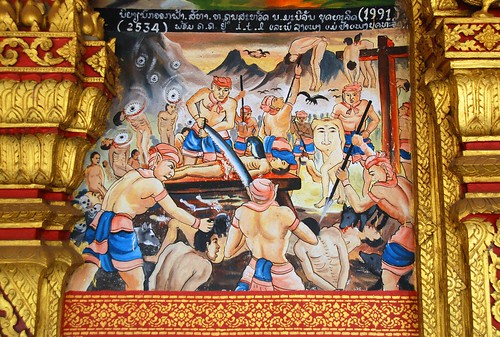
One of the violent scenes painted on a wat exterior.
We spent a couple of evenings wandering around the night market, which is also a huge attraction in Luang Prabang. This, too, was a big shock for us…for the first time, we saw things that tourists might actually want to buy (rather than cheap ethnic trinkets and North Fake backpacks)! There was an artisanal quality to many of the goods for sale in the LP night market that we hadn’t seen anywhere else in SE Asia.
One day, we rented bikes and went for a ride to some of the neighboring villages. I forget the name of the first village, but it was about 6km outside of LP. There wasn’t much to see there, but it was a nice ride and we had fun waving to the kids and yelling, “Sabai-dii!” (”Hello!” in Laotian). Feeling emboldened, we decided to head out for a longer ride towards Ban Phanom. Near the beginning of the dirt road toward the village, there was a really lovely wat on a hill; we wandered around inside and were delighted to find 5 levels…with each level getting progressively smaller until the top-most room was only big enough to hold the two of us and a dozen or so Buddha statues.
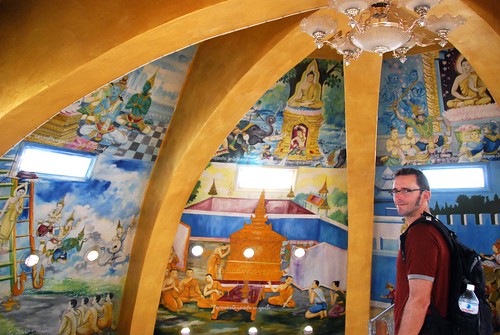
Jeremy in the second room from the top of the multi-level wat.
Our goal on this little bike excursion was the tomb of Henri Mouhout, a French explorer who “discovered” Angkor Wat and died in Ban Phanom of malaria, where the French built a small shrine at his final resting place. Little did we know that we had pushed our biking luck, for the next several hours involved bone-rattling dirt roads full of pot holes, an irrefutably unhealthy amount of inhaled dust (along with the smoke), one flat tire, and lots of huffing and puffing. It was EPIC.

Our bikes sure were cute, but they didn’t exactly make for a comfortable or effortless ride.
Luckily, Henri’s tomb (which was totally anticlimactic, by the way) was located right next to the Nam Khan river, because we were so overheated and dusty by the time we got there, we didn’t even stop to think how dirty the water might be (the water WAS flowing swiftly and there were other people swimming in it…how bad could it be?!?). ![]()
The next day, we took it easy and opted for boat trip up the Mekong to see the Pak Ou caves, which are stuffed full of Buddha relics. The boat trip to the caves was upriver, and it was so painfully slow that any thoughts we had of taking a boat to Thailand were completely obliterated (the boat trip back, which was downriver, was far more pleasant; it makes sense that taking a boat from Thailand into Laos is the more popular direction of travel).
The lower cave of Pak Ou was absolutely filled to the brim with Buddhas, but it was also full of tourists. ![]()
The upper cave is very deep and enclosed so it is pitch black inside (i.e., good thing we brought a flashlight!). They built an entrance right into the side of the mountain, which I thought was just lovely.
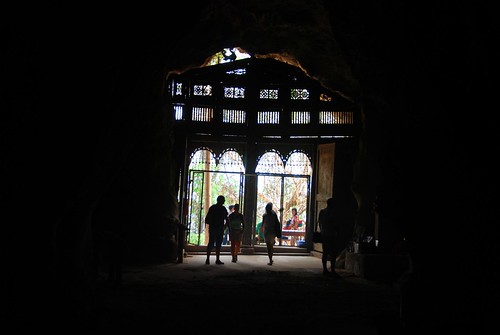
Beautiful gate built right into the cave entrance.
Luang Prabang is a really lovely, peaceful town (there’s even a midnight curfew). It is also (to our surprise) quite fancy, which means that prices can be quite high here. We were expecting Laos to be cheaper than the rest of SE Asia, but in LP that is definitely not the case. We got lucky and paid US$15 for a nice room with air conditioning (and a view of the monks going for alms in the morning), but everywhere else on our block, rooms were US$30 and up. Restaurants are also quite expensive, but we eventually learned to buy our lunches and dinners at the market, where prices were closer to our budget (about US$0.50 to US$1 for a big sandwich or a plate at the vegetarian buffet).
We enjoyed our time in LP (it’s hard not to—the town is just so freakin’ peaceful!), but I’m not sure that we ever connected with the place. Perhaps it was the fanciness that didn’t quite gel with us, or maybe, just maybe, we do need a little bit of noise and ruckus to really feel at home in this world.
There’s no point in beating around the bun cha: we adore Vietnam. There are so many scenes imprinted on my mind from this beautiful country: high school girls riding their bikes home as their white ao dai (traditional Vietnamese uniform of Chinese-like dress worn over pants) flap in the wind, the toothless man rowing his boat in the river near Hoi An’s Old Quarter, smiling big for the tourist cameras, the ladies at the guesthouse in Sapa who hijacked my iPod for an hour and giggled as they zoomed in and out on our wedding photos. I can’t speak for Jeremy, but I was positively entranced by the people in this country. Even though some of our experiences with the locals in Vietnam occurred under contrived situations (i.e., tours), I never felt as if there were any walls between us (whereas I have felt, in other SE Asian countries, the uncomfortable bargain that has been made between Westerners and locals—tired of too many disappointing experiences, both sides have limited themselves, almost exclusively, to the interactions within the service industry). Thousands of miles and different experiences separate their culture from ours, but I really felt that the people in Vietnam were genuinely interested in knowing us and, in turn, sharing with us their lives, their difficult history, and their view of the world.
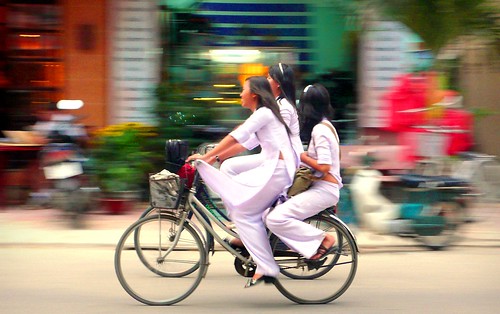
High school girls riding home from school in Nha Trang.
Day spent here: 21
Places we would like to visit next time: the Central Highlands.
Prices: We found Vietnam to be very cheap in terms of both food and accommodation. We spent between US$6-15 per night on lodging, and a meal could cost as little as US$1.50. Prices seem to be higher in the north than they are in the south, with some of our dinners in Hanoi reaching up to US$10.
Almost everything can be bargained for in Vietnam. We didn’t have a ton of luck bargaining over our accommodation, but you can expect that the first price quoted to you for clothing, taxi rides, and pretty much anything except for food and drinks is going to be about 2 (or sometimes 3) times the price you will end up paying for it.
By the way, I am quoting prices in US dollars, but the Vietnamese quote prices in both dong and dollars, though all payment is made in dong (you just convert the US price over to dong). The going rate while we were in Vietnam was 17,500 VND = US$1.
Weather: Vietnam is a surprisingly big country with many different climates. While we were there (mid-February), the south was swelteringly humid, while the north was quite cold. It was cold and rainy in Hanoi and foggy in Sapa. Central Vietnam was quite pleasant; Dalat, had a very pleasant mountain climate, with warm days and cooler nights. Bottom line, you can get a little bit of everything in Vietnam, which is pretty refreshing considering all other SE Asian countries have just one temperature: HOT.
Hotels: Each country in SE Asia seems to have minor differences in their hotel protocol; in Vietnam, you have to show your passport upon check-in (and sometimes the hotel keeps it, which can be unnerving at first). We stayed in some nice budget places in Vietnam…it seems that once you get into the US$10 and up range, the hotel rooms are clean, comfortable, and spacious. And, the hotels clean your room and make up your bed every day (not necessarily true in other SE Asian countries, where they only clean the room between guests).
Transit: Getting around Vietnam is quite easy to coordinate; there are travel agencies selling plane, train, and bus tickets everywhere you look. The quality of your train or bus is another matter entirely. It’s a good idea to ask a lot of questions, and if possible, ask the agency to show you photos of the train or bus. We traveled into Vietnam by boat, flew (from Hoi An to Hanoi), took the train (from Hanoi to Sapa), bussed it (including an overnight bus from Dalat to Hoi An…more on that lovely experience later), and also did some short trips aboard minibuses (basically, large vans). We found plane and train travel in Vietnam quite comfortable. Our buses were nice about half the time, and not so nice the other half. Minibuses were basically torture on wheels (mostly because they shove about 3-4 more people than is comfortable into these small vans), and after a few bad experiences in the south, we tried to avoid them. Perhaps if you are small, minibuses would be a fine way to travel (but we’re 12FOOT3).
Since Vietnam is so big, it can take quite a while to get from one destination to the other. For example, in order to get from Dalat to Hoi An, we had to take a 7 hour bus from Dalat to Nha Trang, get off the bus for about 4 hours, and then get back on an overnight bus that dumps you off in Hoi An at 5AM. So, you won’t be surprised to hear that when we were faced with an 18-hour bus ride from Hoi An to Hanoi, we looked into other options. The train in Vietnam can be quite nice, and it can be a historical experience (with many people riding the famous Reunification Express). We opted to fly, since, at US$36, the flight from Hoi An to Hanoi was only US$6 more expensive than a sleeper car on a train (and about 17 hours faster). It pays to do your transit homework. ![]()
Travel within a city or town is quite easy, with motorbikes and bicycles for rent for cheap. We were only brave enough to join traffic in the smaller towns, though…you might want to have your head checked if you think driving a motorcycle or riding a bike in Saigon or Hanoi is a good idea. Not only are the drivers completely insane, but they carry incredibly dangerous-looking loads on their motorbikes (and continue driving as if they are unencumbered by an extra 40 kilos of stuff strapped to their bike). We saw many travelers who looked like they had been in recent motorbike accidents (with bandaged appendages and facial bruising). Um, no thank you.
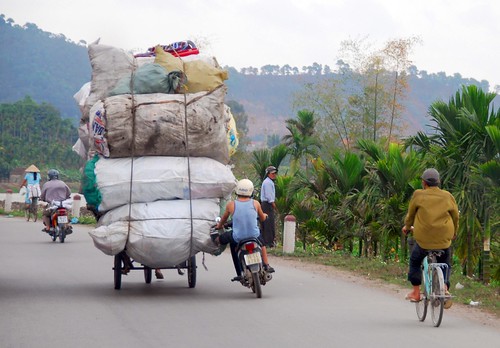
You want to strap fifteen feet of stuff to my bicycle cart? No problem!
Internet: Awesome. We never once paid for access in Vietnam. There are open wi-fi connections everywhere. It’s kind of crazy that internet access in SE Asia is more available than in Australia! C’mon Aussies! Time to join the, um, 1990s.
Food and drink: Oh man, Vietnamese food is sooo good. It’s definitely simple, but that doesn’t detract from its general awesomeness. Of course, pho bo (beef pho) is the one dish you cannot leave Vietnam without eating (and oh, did we eat it). The key is to order it with the beef half-cooked or rare (it will fully cook in the boiling hot broth), and accessorize the broth with the various sauces on the table.
The food in the north is definitely the best; we’ve already professed our love for bun cha and cha ca. Vietnamese sandwiches and chinese-style buns (which we only found in the south) were also quite good.
The Vietnamese are unapologetic carnivores and will eat anything. Yes, including dog (though we only saw this on the north). You can tell if a restaurant serves dog if its sign reads, “Thit Cho.” We also saw restaurant menus including strange things like, “roasted camel,” “field mouse,” and “musk cat.” Where the heck do you get a camel in Vietnam?!?
A young Brit that we met in Hoi An told us how he went to a cobra restaurant near Hanoi. They bring out a basket full of snakes, you pick the one that is going to be your meal, and they club it to death right there in front of you. Then they squeeze the blood out of it into a shot glass full of vodka, and you shoot it down. Intense.
We didn’t partake in the cobra meal, but we did see cobra wine for sale. It is supposed to make the drinker “more potent” (whatever that means).
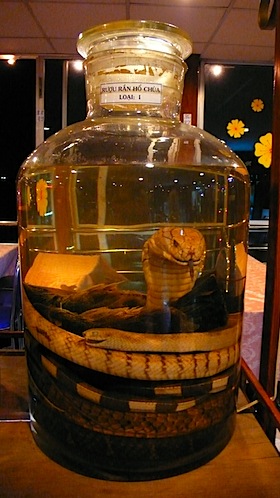
Cobra wine in Can Tho.
Another (less frightening) alcoholic drink in Vietnam is bia hoi. It is freshly-brewed Pilsener-style beer that is pretty much the cheapest pour you can find in the country (about 4000 VND, or approx. 23 cents per glass). It is quite tasty and surprisingly strong.
And we can’t forget to mention Vietnamese coffee. Oh. My. God. So good and so, so strong. I usually had to dilute mine with about twice as much water. Once you’ve had that sweetened condensed milk in your rocket fuel, you can never go back.
Scams: We heard many other travelers complaining about problems they had in Vietnam, though we never experienced any. Most scams are related to transit. In Hanoi, it can be difficult to convince a cabbie to use the meter, but when our Aussie friends finally found a taxi driver who would use the meter, it was rigged to run about 3 times faster than it should have. They simply paid what the ride should have cost (after they got their luggage out of the cab), and left.
We’ve also heard stories of people agreeing on a price, and when they get to their destination, the cabbie insists that the fare was per person. There is a similar bus scam, where the driver stops in the middle of nowhere and insists on more fare to take you further. And, the most inventive scam (we think) is the one where a bus driver takes the longest and bumpiest route to a destination so that you are more likely to check into the overpriced hotel (that is no doubt “sponsoring” the bus driver) he drops you off at.
Again, we had no problems whatsoever and found Vietnamese people (except in Hanoi) ![]() to be quite lovely, and more than willing to try to understand your silly pantomime communications. It’s true that they are commerce-oriented, but we also found them to be curious and friendly even after the monetary transaction was completed.
to be quite lovely, and more than willing to try to understand your silly pantomime communications. It’s true that they are commerce-oriented, but we also found them to be curious and friendly even after the monetary transaction was completed.
In short: Vietnam is a gorgeous, varied country. Not only did we meet some fabulous locals here, but the travelers in Vietnam are super cool too! We would highly recommend Vietnam as a destination…it is, quite possibly, our favorite country in SE Asia.
Check out our photos from Vietnam:
Somewhere around Hanoi, we made the hard decision to skip diving in Sipidan (we had been planning on ending our tour of SE Asia by diving in eastern Malaysian Borneo, reportedly one of the best scuba sites in the world right now). On the one hand, we really, really want to dive here before it gets polluted/overvisited/crowded and the animal and plant life starts to die off. On the other hand, with flights, accommodation, and diving, it will cost us over US$1000 to dive for 3 days here. Not only would that really strain our budget, but we’re currently spending that much every 2 weeks or more in SE Asia. So…two weeks of experiences or three days? It’s always a trade-off while you’re traveling (as you’ll hear many backpackers lament)—an extra day Here means you won’t see There; an airplane ride There means you miss the opportunity to hop off the bus Here.
On the plus side, NOT diving Sipidan meant we could push back our leave date and travel a little more leisurely through the rest of SE Asia, which is really, really luxurious. As it is, we are traveling much more slowly than many backpackers around here, who move from place to place every 2 days or so. I understand that—the hunger for new experiences and the fear of missing out—and I feel it tugging at me every so often, but I think Jeremy and I have found a healthy balance between wandering and staying still here in SE Asia, and it feels good to have the luxury to move slowly now that we don’t have the pressure of getting to Sipidan by a certain date.
One opportunity that opened up as a result of cutting Sipidan was Sapa. Sapa is a small town in the mountains northwest of Hanoi, near the China/Vietnam border. It is famous for its wealth of ethnic tribes that live there, and most people do a one-, two-, or three-day trek in the mountains through various villages. The only way to visit Sapa is to take a 9-hour overnight train there, which turned out to be quite pleasant! Private companies purchase and maintain certain cars on the train, so if you buy a “soft-sleeper” class ticket (about US$25 or so), you spend the night in a clean, comfortable car with 4 beds (2 bunks). The only downside is that you arrive in Sapa at 5AM, which is painful any which way you look at it.
When we arrived it Sapa, it was very foggy (it would stay that way the entire time we were there), and coupled with our grogginess, I felt like we were in a dream…a dream that had us walking through a National Geographic. There are tribal people everywhere around town dressed up in their finest clothes to sell stuff to tourists. Clothing differs based on the tribe, but many men wear long petticoats over indigo-dyed pants and tunic, while women accessorize with brightly-colored headscarves, woven tapestries, and silver accessories.
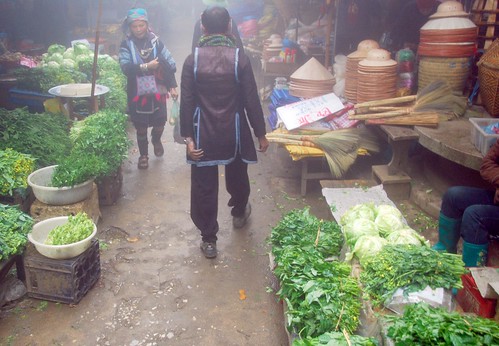
Walking through the market in Sapa.
We spent our first day in Sapa wandering around local Cat Cat village (a short hike from town but not very scenic), and looking for a trekking tour. Like Halong Bay, you can book a tour of Sapa in Hanoi, but it is pretty easy to travel independently to Sapa and you’ll save money booking a tour in town vs. in Hanoi. Most overnight tours include a village homestay, and after our experience in Vinh Long, we were worried about having a disappointing, “manufactured” experience if we opted to go that direction. So, at first, we were planning on just doing a day hike, especially since it was my 32nd birthday the next day. But after talking to a couple of different tour agencies, we decided on a two-day trek that would begin in Ta Van village and end with a homestay in Ban Ho village (mostly because Ban Ho village is at a much lower elevation than Sapa, which would allow us to get below the thick fog and actually see some of the countryside, but also because Ban Ho is further away from Sapa, and we thought that might mean there were fewer tourists). Though it would be lovely to spend my birthday with Jeremy, eating a nice meal and sleeping in a comfortable bed, I figured, hey, you only turn 32 once…why not spend it with a hill tribe family in the Vietnamese mountains? ![]()
We are really, really glad we chose to go this route because it ended up as one of the best experiences we’ve had on our trip so far. Even better, we booked our tour through our hotel (Lotus Hotel, where we had an incredible room for only US$6), and it only cost US$23 each (we would find out through some of our fellow trekkies—who did quite a bit of shopping around—that this was one of the cheapest tours around Sapa).
We were picked up in the morning by our tour guide, Thuyen (a spunky, 22-year-old Vietnamese girl who did the entire 18km hike in plastic galoshes), and we met the rest of our crew in the van that would take us to Ta Van. There were 6 of us in total: two German girls (Katrin and Gesina), a German guy (Ben), and an English girl (Jo).
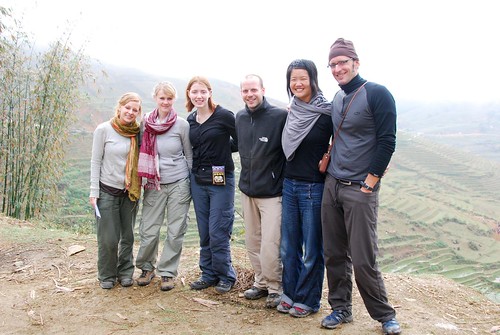
The crew: Katrin, Gesina, Jo, Ben, me, and J. For some reason, we look enormous in this photo.
As soon as you leave Sapa town, you begin to see those famous rice terraces that this part of the country is known for (well, maybe you can actually see them in Sapa but it was too foggy for us to see anything in town). It is absolutely incredible how these people have transformed the mountains—it reminded me of some of the best earthworks or Goldsworthy-esque feats of environmental manipulation.
We arrived in Ta Van and were immediately swarmed by Hmong (the name of the local tribe) ladies upon exiting the van. We didn’t really know what was going on, but they had decided that they would be our entourage on this trek, and followed us closely the entire hike through Ta Van village.
The ground was incredibly muddy and slippery due to heavy rains the previous night, and early on in the trek, I slipped and fell. I wasn’t hurt at all, but the locals are so steady on their feet around this terrain that falling is unheard of, so throughout the rest of our hike in Ta Van, I became The Falling Girl…whenever we approached some tricky or steep part of the trail, two Hmong women grabbed my hands and practically pushed or dragged me up the hill (they are surprisingly strong). This must have been a funny sight, as they are so tiny that I am practically twice their size. To add insult to (non-)injury, they are all wearing plastic sandals and galoshes (while we are in our fancy outdoor hiking hoes). Honestly, I didn’t really need their help, but still, I was grateful at some points to have someone to hold on to!
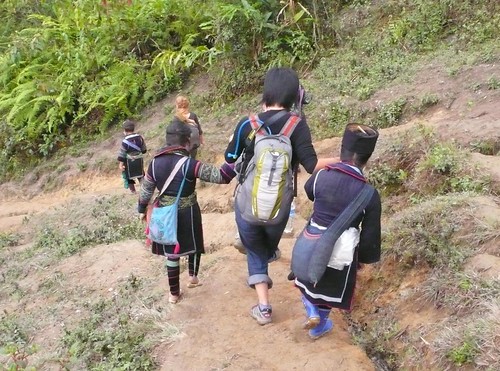
Two Hmong ladies helping The Falling Girl.
The countryside was absolutely gorgeous. We loved seeing how people live in this village, huts set amongst rice terraces.
We finished our hike through Ta Van at a waterfall, and that’s when we finally figured out why we acquired an entourage. Out came the various tourist trinkets and knick knacks that were previously hidden underneath the folds of their clothes and in their basket backpacks. I really wanted to buy something to thank these ladies for all their help and company through the hike, but I just didn’t like anything and didn’t want it to take up space in my already heavy backpack. Ben had given one of the women 20,000 Vietnamese dong (VND), the equivalent of about US$1.15. He told her, “I don’t want anything, but I don’t want you to try to sell me anything either.” So, we tried doing this as well…Jeremy gave one woman 20,000 VND and I gave each of the women who helped me 10,000 dong, but they begged for more. I would have given them more but the only bills we had were very large, like 200,000 VND (approx. US$23.50, which is a fortune around here). Note to self: next time you’re in the Vietnamese mountains hiking with a bunch of Hmong hill tribe ladies, remember to bring small bills.
It was an uncomfortable and sad experience there near the waterfall…these women had walked the entire distance of the village with us on the small hope that maybe we would feel bad enough to buy something from them. I wished that they had something I liked. I wished that we had brought smaller bills. I wished that they knew how to make things that were more useful to trekkers (rather than wind pipes and small, woven purses). I wished that in their tribe, the people went to school so that they didn’t have to rely on selling stuff to tourists. It is a sad but true state of affairs here in Sapa.
We spent the rest of our hike getting to know the rest of our trekkers and Thuyen, and asking her lots questions that she couldn’t answer (what she lacked in English skills, she made up for in enthusiasm). We never acquired another entourage, which suited us just fine, because we encountered lots of people on the road to Ban Ho, and waved at little kids running loose in the countryside.
Finally, we started descending into the valley that holds Ban Ho village.
We arrived at our homestay, where a small homemade sign told us that this was Mr. Ma A. Hu’s home, which offered “Homestay, Food & Drinks, and Cultural Show”. Again, our Vinh Long doubts came rushing back…we were worried that we were going to have to sit through some uncomfortable display of Vietnamese ethnicity, especially since Thuyen kept talking about the “singing and dancing” that lay ahead in the evening.
The house, like most rural homes in SE Asia, is made of bamboo and built on stilts. You walk upstairs and enter a large room, which has several smaller “rooms” branching off it. This is when we got our first indication that our homestay experience here wasn’t going to be like the one we had in Vinh Long. Right as you walk into the house, there was a small altar with candles, a medium-sized slaughtered pig (with incense sticks in his mouth) and 4 chickens that looked as if they had been plucked and immediately dunked straight into boiling water—with their heads and feet still attached. It turns out that someone in the family is sick and some local elderly women were invited to the home to conduct a good luck ceremony for the family (we were not allowed to take photos of this), but it was quite a sight…we weren’t really expecting to see any slaughtered animals, much less inside the home, about 20 feet from where we were to sleep.
Jeremy and I slept in one room and the other 4 trekkers in another.
After chilling for a while at the house (we were pretty tired after walking 18km!), we headed off to the local hot (actually, warm) spring for a quick soak. Most homes do not have hot water in Ban Ho so this is the place where most locals bathe. Men and women sit in different pools…women go into an enclosed hut (shown on the left in the photo below), while men get two huge pools with the nice outdoor view.
After we got back to the house, Thuyen went into the kitchen to cook our dinner. Many more people had congregated at the house, and as usual, we were in the dark as to what was going on…we just sat back and enjoyed the company.

We don’t know who this lady was, but she lived at the house (maybe Mrs. Hu’s sister?). Her baby was adorable, and already knew how to wave and say, “bye bye!”. By the way, if you’re wondering what the mark on her forehead is, many of the local tribes near Sapa practice Chinese medicine. The mark is from a cupping-type procedure in which a buffalo horn is heated and placed on the forehead.
Soon, dinner was served. It was quite a feast! There was waaaay too much food for all of us, but we did our best. Mr. Hu and his eldest son sat with us at the table, each of them holding a 1.5L Aquafina bottle. When they brought out the shot glasses, we realized the bottles were filled with their homemade rice wine (not water). We also realized that Mr. Hu and his son were on a mission. A mission to get us drunk. Seriously, they did not stop pouring the entire night. We were taught how to say “cheers” in Vietnamese: “mo, ta, bai…YO!!!,” a phrase that Thuyen gleefully yelled with much conviction every 3 minutes or so as they refilled our shot glasses (again).
In the middle of dinner, Thuyen ran off into the woods somewhere (Ben was theorizing that she had a boyfriend in the village, but we were skeptical). Just as we were starting to come up with more and more elaborate theories (in our drunken state), Thuyen returned…she had run into the mountains to pick me flowers for my birthday (and somehow found a little plastic clock as a birthday gift). It was an incredibly sweet and thoughtful gesture, and everyone was commenting on how she had gone above and beyond a tour guide’s duties. I think it was around that time that she started calling me her “sister.” ![]()
This photo captures the spirit of that night very well: chaos, shot glasses in the face, and new friendships.
Suddenly, it was a PARTY! Thuyen announced that it was time for the dancing, and we were bracing ourselves for a bunch of people being paraded out in their “traditional” costumes. Instead, quite unexpectedly, our homestay family popped in a video of some thumping Asian disco featuring a scantily-clad go-go dancer gyrating to techno music. This was our “cultural show.” ![]()
The rest of the night starts to get a bit fuzzy…we played camera tag with all the adorable kids running around (they would hide as our flashes went off), Thuyen and I danced to techno music, we threw back about a million more shots with Mr. Hu and his son, and at some point we were invited to the big room in the main house for “second dinner.” We didn’t understand what was happening at the time, but after a while we figured out that many members of the village were invited to the Hu’s house to share in the slaughtered pig and the four chickens that were sacrificed in the good luck ceremony.
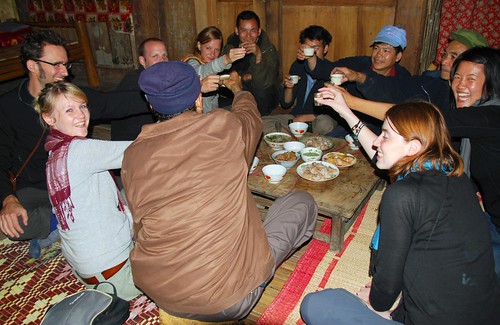
Taking yet another shot of rice wine.
Needless to say, we had an incredible time. Jeremy was very concerned with Sapa being too much of a “human zoo,” but this experience erased any doubts from our minds…instead of some contrived ethnic show, our homestay family showed us what they were really into: traditional animist blessing ceremonies set against the backdrop of club dancers grinding their hips to loud, cheesy techno. We were fascinated by the clash of old and new cultures and appreciated the fact that they didn’t adhere to tradition just for our sake.
When we woke up the next morning, I was (surprisingly) feeling fine, but the others were quite hung over. We had a slow morning, wandering around the village to a waterfall, and then returning to Mr. Hu’s house for lunch before we headed uphill back to Su Pan village to get picked up.
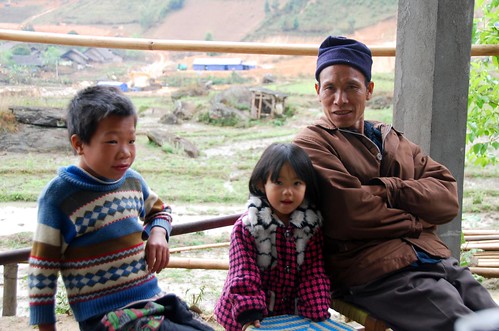
Mr. Hu with…his grandkids? We never could decifer how (or even if) they were related.
I am so glad we didn’t opt to stay behind in Sapa to have a nice dinner and sleep in a comfortable bed. I am so glad that we were rewarded with this amazingly memorable experience after opting to skip out on another one (Sipidan). This was definitely one of the most special birthdays I’ve ever had…thanks birthday fairy! It’s gonna be a good year.
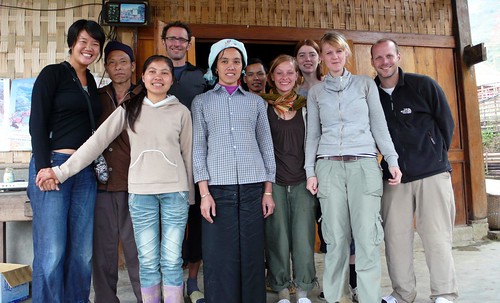
One big happy family (how cute is it that Thuyen wanted to hold my hand for the photo?!?).
More scenes from our trek:
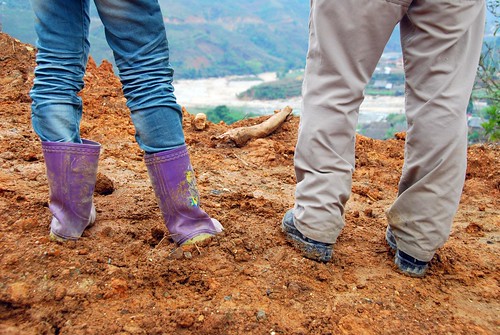
Thuyen’s plastic galoshes and Ben’s German hiking boots in the mud.
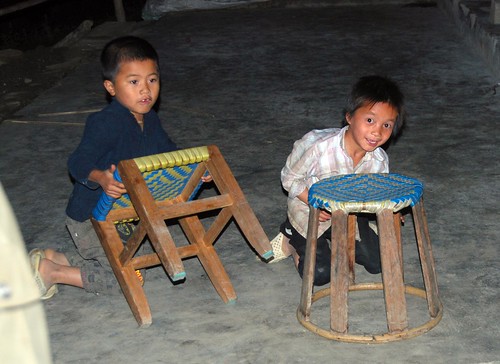
Playing camera tag with the kids.
We high-tailed it out of Hanoi and headed for the (relative) peace and quiet of Halong Bay, a very touristy (but beautiful) location about 3 hours east of The City that Broke Us. Halong Bay is known for its hundreds of islands with limestone cliff formations…it is quite an unusual place, and unlike anything we’ve ever seen before. It kind of made me think of Milford Sound in New Zealand—if all those big cliffs got together and multiplied like rabbits, they’d make Halong Bay.
The way that most people see Halong Bay is on a one, two, or three day cruise aboard one of the many “junks” (Chinese-style boats) that motor around the bay. The junks are built with fake sails, which are quite charming at first, and then kinda silly as you look closer (since the sails are so obviously decorative).
It takes 3 hours (one-way) to drive out to Halong Bay from Hanoi, so we opted against the day trip. The 3-day trip includes a one-night stay on the junk and one night on Cat Ba Island. One thing we’ve learned from our trip so far is that we really love being on boats. We sleep like babies on the sea…Jeremy has even suggested that we rig up our bed on some wires to mimic the gentle rocking you get on a boat. I hope he’s joking.
Anyway, we thought a 3-day trip might be a little too long for us, so we opted for the 2-day/1-night trip with an overnight on the boat (you can also choose to stay on land if you are prone to seasickness). As I mentioned in my previous post, there are (possibly) hundreds of people selling tours to Halong Bay from Hanoi. The price for a 2-day/1-night trip can range from US$35 to US$200! Lonely Planet suggested that most people who pay a little more than the rock-bottom budget trips (US$35-45) are usually happy that they did so…the budget trips tend to serve small meals, the accommodation is a bit sketchier, etc. They had us at “small meals.”
So, we set about looking for a mid-range tour of Halong Bay. We went to about 10 different tour agencies and finally settled on Vega Travel, which charged us US$72 each for the trip. This was a bit steep for us, but we couldn’t find anything in the US$50-60 range—tour prices seem to make big jumps rather than small ones—from US$40 to US$70 to US$150.
It’s worth noting that when Grace and Susan went to Halong Bay in 2004, they paid only US$20 for their tour. That is how much prices have risen here in the past 5 years…the rock-bottom budget tours are now twice as expensive!
A couple of realities about Halong Bay tours:
1. There are TONS of boats out in the bay. Don’t expect to be alone out here, because you won’t be.
2. The boats all travel (more or less) the same course (or, it seems, some of them travel the same course, but backwards).
So, the fact is, more than likely, someone who pays US$45 will get the EXACT same tour as someone who paid US$200. The only difference will be the accommodation and the food.
We thought a US$30 premium for a nicer room and good food was too steep, but we are happy that we cruised Halong Bay in the Vega boat, mostly because we met some really nice people on our tour. There were 10 other people on our boat, including a Russian family of 3, two Aussies, a Turkish/Swedish couple, two Indian girls, and a Belgian guy who teaches English in India. Everyone was super nice and we really enjoyed hearing everyone’s travel stories. We spent the most amount of time getting to know the Aussies, Brad and Suzanne, who live in Melbourne (holler!).
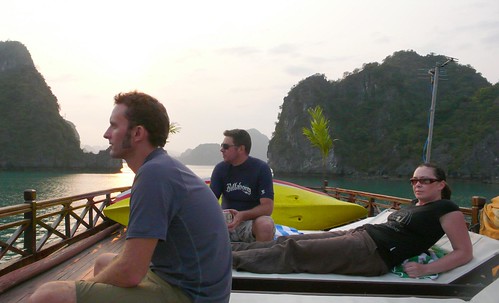
Jeremy, Brad, and Suzanne on the upper deck of the Vega boat.
On the first day of our cruise, the boat headed for Surprising Cave (yes, that’s the name). It is called “Surprising Cave” (spoiler alert!) because of a large stalagmite that looks like a penis. Classy. We weren’t really surprised by this, but we were surprised by how big the cave was. We thought it was going to be a lame little cave that you stick your head inside. But no, it’s huge! Like, it took us a good 15 minutes to walk through it.
The typical Halong Bay cruise also includes a hike to the top of Titop Island, where there are stunning views of the swimming beach below.
After the hike, you jump in a kayak and paddle your way to an enclosed lagoon. Jeremy and Brad decided to go for a swim after our kayaking session, and jumped from the top of the boat.
That weather wasn’t great while we were in Halong Bay, but the overcast fogginess made the atmosphere kind of dramatic, and we got some thunderstorms that night, which was super cool! It was neat to see all the islands illuminated by lightning as we ate our dinner.
Once again, our experience in Halong Bay was one in which the company of two other cool travelers really made it for us. So thanks, Brad and Suzanne, for hanging out with us!
Our time on the Vega boat was totally fine. The room was quite nice and the food was great and plentiful. We still think it’s overpriced at US$72, but that’s the lowest “just-above-rock-bottom-budget” price we could find, and we’re grateful for the cool group we met on the boat.
And Halong Bay? Definitely worth seeing, but we’re glad we only did the 2 day cruise (our instincts were right…3 days would have probably been too much). If you ever make it to this part of the world, just keep your expectations in check…there are tons of motorboats out here, which inevitably leads to pollution and crowding. Vietnam is trying to get Halong Bay listed as one of the “New 7 Wonders” of the world (we don’t really know what this means). Hopefully the government can do something to keep the boat traffic in check and preserve this natural beauty.
